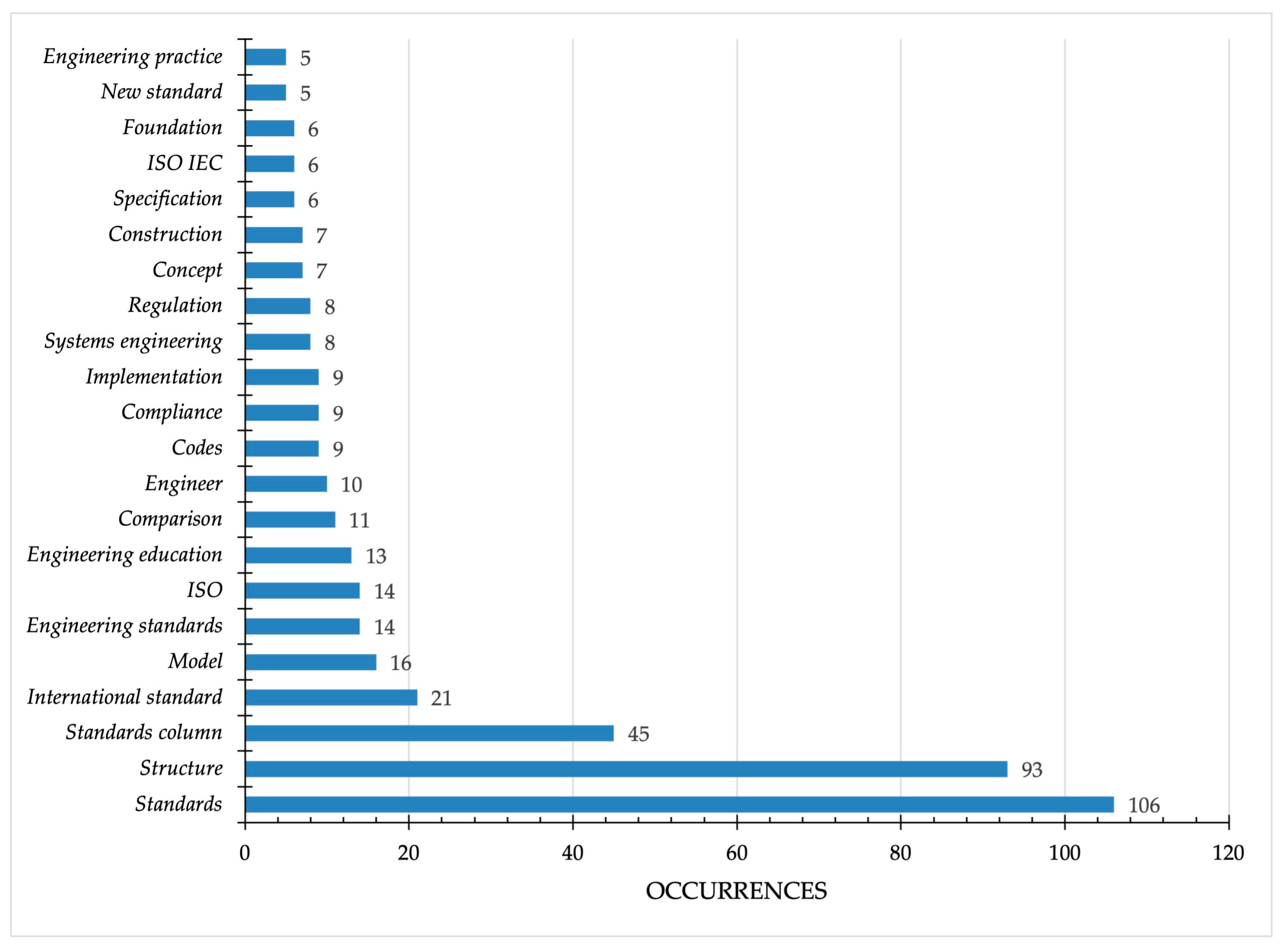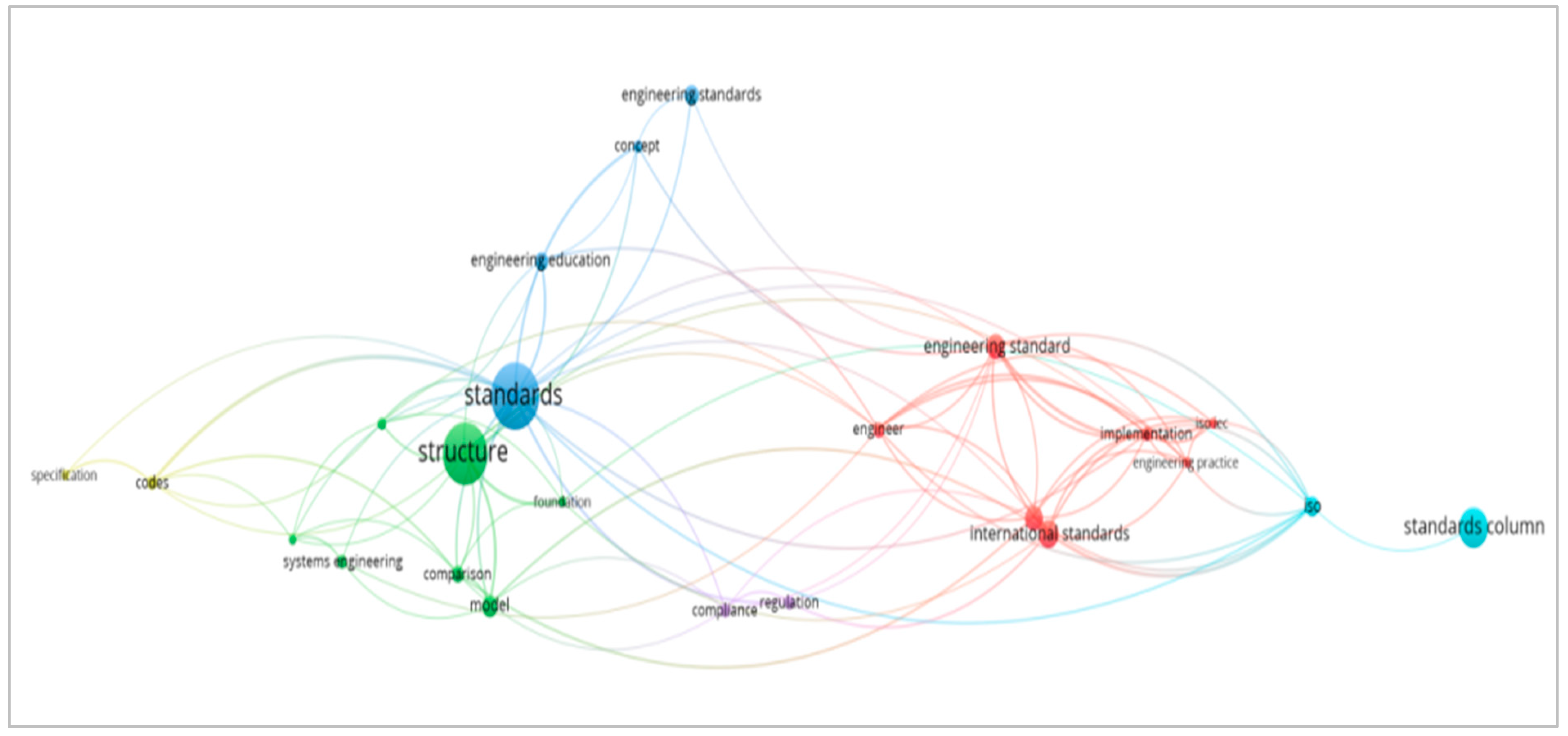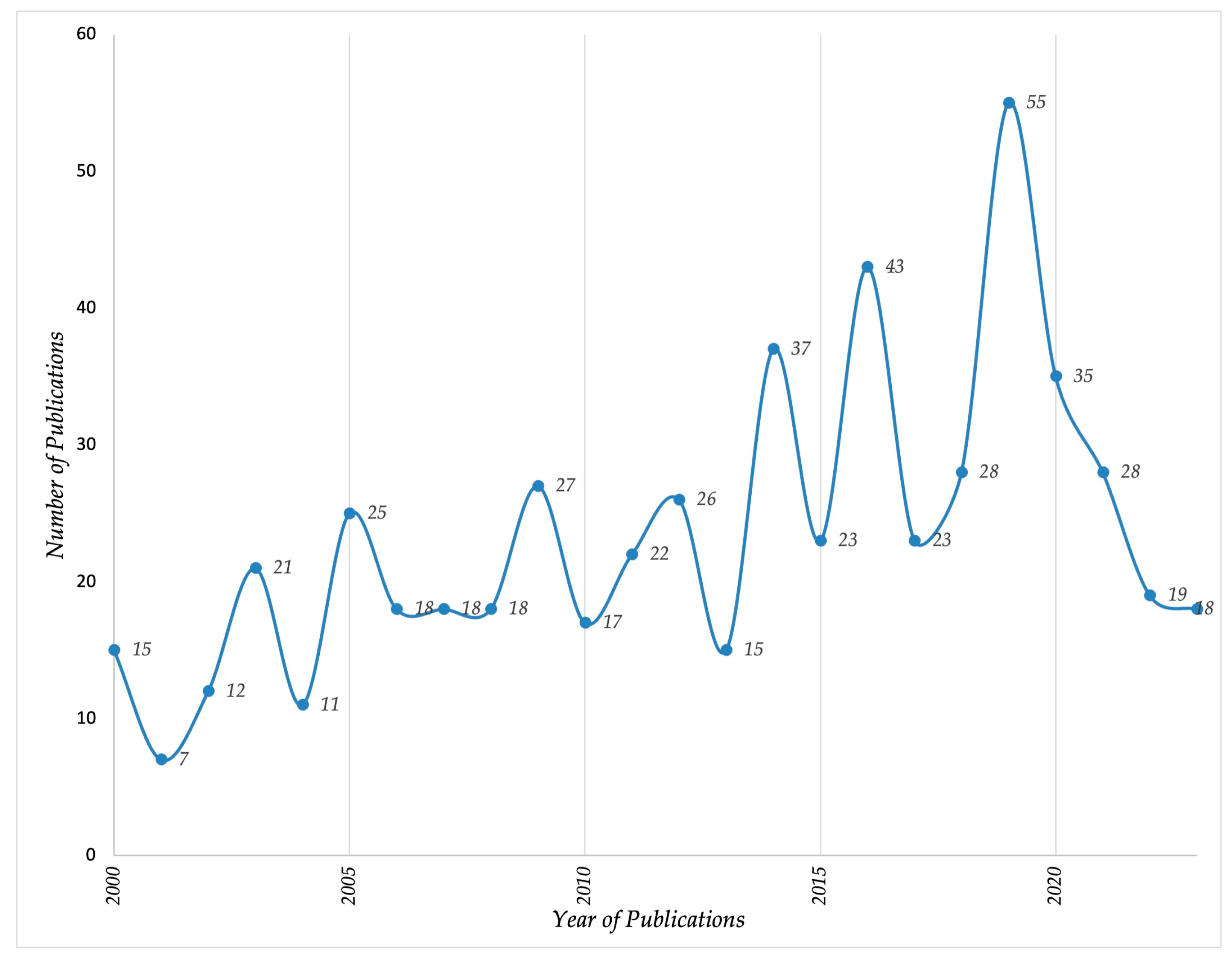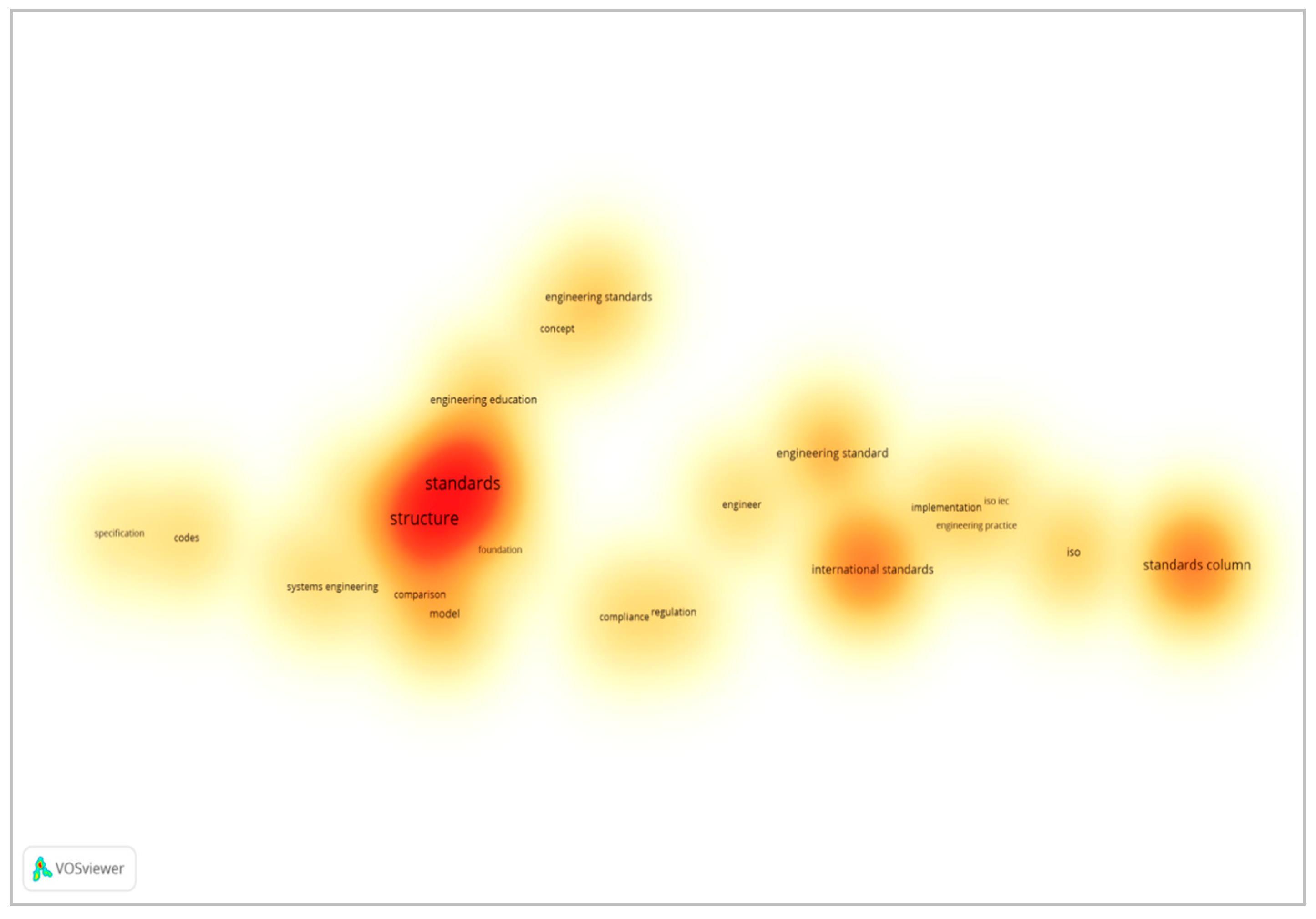A Bibliometric Analysis of International Structural Engineering Standards Using VOS Viewer †
Abstract
1. Introduction
2. Literature Review
2.1. Civil Engineering
2.2. Structural Standards
2.3. Types and Materials of Structures
2.4. International Standards Used Currently
3. Methodology
4. Result and Discussion
4.1. Keywords Association
4.2. Total Study Issued per Year (Trend Analysis)
4.3. Keywords Density
4.4. Study Based on Publisher
4.5. Study’s Origin by Continent
5. Conclusions
Author Contributions
Funding
Institutional Review Board Statement
Informed Consent Statement
Data Availability Statement
Conflicts of Interest
References
- Bredillet, C.N. Genesis and role of standards: Theoretical foundations and socio-economical model for the construction and use of standards. Int. J. Proj. Manag. 2003, 21, 463–470. [Google Scholar] [CrossRef]
- Bado, M.F.; Casas, J.R. A review of recent distributed optical fiber sensors applications for civil engineering structural health monitoring. Sensors 2021, 21, 1818. [Google Scholar] [CrossRef] [PubMed]
- Hiyassat, M.A. Applying the ISO standards to a construction company: A case study. Int. J. Proj. Manag. 2000, 18, 275–280. [Google Scholar] [CrossRef]
- Zavadskas, E.K.; Antucheviciene, J.; Vilutiene, T.; Adeli, H. Sustainable decision-making in civil engineering, construction, and building technology. Sustainability 2017, 10, 14. [Google Scholar] [CrossRef]
- Soto, M.G.; Adeli, H. Multi-agent replicator controller for sustainable vibration control of smart structures. J. Vibroeng. 2017, 19, 4300–4322. [Google Scholar] [CrossRef]
- Rafiei, M.H.; Adeli, H. Sustainability in highrise building design and construction. Struct. Des. Tall Speéc. Build. 2016, 25, 643–658. [Google Scholar] [CrossRef]
- Oh, B.; Kim, K.; Kim, Y.; Park, H.; Adeli, H. Evolutionary learning based sustainable strain sensing model for structural health monitoring of high-rise buildings. Appl. Soft Comput. 2017, 58, 576–585. [Google Scholar] [CrossRef]
- Wang, A.J. Design and construction innovations on a skyscraper cluster in China. In Proceedings of the Institution of Civil Engineers-Civil Engineering, London, UK, 1 November 2017; Volume 171, pp. 91–95. [Google Scholar]
- Jamoussi, B.; Abu-Rizaiza, A.; AL-Haij, A. Sustainable building standards, codes and certification systems: The status quo and future directions in Saudi Arabia. Sustainability 2022, 14, 10314. [Google Scholar] [CrossRef]
- Al-Kodmany, K. Constructing Tall Buildings in China: With a Focus on Shanghai. Int. J. High-Rise Build. 2024, 13, 33–56. [Google Scholar]
- Iliescu, A.N. Conceptual atlas of the known literature: Visual mapping with VOSviewer. Manag. Dyn. Knowl. Econ. 2021, 9, 379–392. [Google Scholar]
- Suradkar, P.A.; Kalbande, D.T.; Patil, D.T. Mapping the Landscape: A Bibliometric Analysis of CALIBER 2022 Convention Publications. In Transforming Libraries in 21st Century; Studera Press: New Delhi, India, 2023; pp. 201–210. [Google Scholar]
- Miccoli, L.; Gerrard, C.; Perrone, C.; Gardei, A.; Ziegert, C. A collaborative engineering and archaeology project to investigate decay in historic rammed earth structures: The case of the medieval preceptory in ambel. Int. J. Archit. Herit. 2017, 11, 636–655. [Google Scholar] [CrossRef]
- Chondros, T.G. Natural philosophy and the development of mechanics and engineering from the 5th century BC to Middle-Ages. FME Trans. 2017, 45, 603–619. [Google Scholar] [CrossRef]
- Bunz, K.R.; Henze, G.P.; Tiller, D.K. Survey of sustainable building design practices in North America, Europe, and Asia. J. Archit. Eng. 2006, 12, 33–62. [Google Scholar] [CrossRef]
- Shamma, J.; Purasinghe, R. Introduction to Sub-Branches of Civil Engineering Fields through a Creative Freshmen Civil Engineering Design Course. In Proceedings of the ASEE Annual Conference & Exposition, Seattle, WA, USA, 14–17 June 2015. [Google Scholar]
- Chinyio, O.P. Construction Stakeholder Management; John Wiley & Sons: Hoboken, NJ, USA, 2009; p. 419. [Google Scholar]
- Hendrickson, C.; Zozaya-Gorostiza, C.; Rehak, D.; Baracco-Miller, E.; Lim, P. Expert system for construction planning. J. Comput. Civ. Eng. 1987, 1, 253–269. [Google Scholar] [CrossRef]
- Basu, D.; Misra, A.; Puppala, A.J. Sustainability and geotechnical engineering: Perspectives and review. Can. Geotech. J. 2015, 52, 96–113. [Google Scholar] [CrossRef]
- Correia, G.A.; Winter, M.G.; Puppala, A.J. A review of sustainable approaches in transport infrastructure geotechnics. Transp. Geotech. 2016, 7, 21–28. [Google Scholar] [CrossRef]
- Chaurasia, D.; Srivastava, H.; Sonker, A.; Mishra, U. Comparision of Steel Structure and Composite Structure on Etabs Under Blast Load. Int. Res. J. Mod. Eng. Technol. Sci. 2023, 2582–5208. [Google Scholar]
- Johnson, R.P.; Buckby, R.J. Composite Structures of Steel and Concrete: Beams, Slabs, Columns, and Frames for Buildings; John Wiley & Sons: Hoboken, NJ, USA, 2004; p. 247. [Google Scholar]
- Rosli, N.M.; Mustaffa, N.E.; Ariffin, H.L.T.; Ya’acob, I.A.M.; Rahmat, M.; Leu, K.S. Crucial conditions of domestic sub-contract in Malaysian construction industry. In E3S Web of Conferences; EDP Sciences: Paris, France, 2022; Volume 357. [Google Scholar]
- Cooklev, T. The role of standards in engineering education. Int. J. IT Stand. Stand. Res. (IJITSR) 2013, 8, 129–137. [Google Scholar]
- Yates, J.K.; Aniftos, S. International standards and construction. J. Constr. Eng. Manag. 1997, 123, 127–137. [Google Scholar] [CrossRef]
- Blyth, A.; Napolitano, R.; Glisic, B. Documentation, structural health monitoring and numerical modelling for damage assessment of the Morris Island Lighthouse. Philos. Trans. R. Soc. A Math. Phys. Eng. Sci. 2019, 377, 20190002. [Google Scholar] [CrossRef]
- Ghuku, S.; Saha, K.N. A review on stress and deformation analysis of curved beams under large deflection. Int. J. Eng. Technol. 2017, 11, 13–39. [Google Scholar] [CrossRef]
- Torrent, R.J. Bridge durability design after EN standards: Present and future. Struct. Infrastruct. Eng. 2018, 15, 886–898. [Google Scholar] [CrossRef]
- Tso-Sutter, K.H.; Karg, L.M. Generic compliance check tool in examining the conformity of company-specific standards to public standards. In Proceedings of the IEEE International Conference on Industrial Engineering and Engineering Management, Macao, China, 7–10 December 2010; pp. 2139–2143. [Google Scholar]
- Terzis, D. Monitoring innovation metrics in construction and civil engineering: Trends, drivers and laggards. Dev. Built Environ. 2022, 9, 100064. [Google Scholar] [CrossRef]
- Asperti, A.; Longo, G. Categories, Types and Structures; MIT Press: Cambridge, MA, USA, 1991; pp. 1–300. [Google Scholar]
- Alvin, K.; Robertson, A.; Reich, G.; Park, K. Structural system identification: From reality to models. Comput. Struct. 2003, 81, 1149–1176. [Google Scholar] [CrossRef]
- Borri, A.; Castori, G.; Corradi, M. Masonry columns confined by steel fiber composite wraps. Materials 2011, 4, 311–326. [Google Scholar] [CrossRef]
- Dominguez-Santos, D.; Mora-Melia, D.; Pincheira-Orellana, G.; Ballesteros-Pérez, P.; Retamal-Bravo, C. Mechanical properties and seismic performance of wood-concrete composite blocks for building construction. Materials 2019, 12, 1500. [Google Scholar] [CrossRef]
- Bismut, E.; Straub, D. Optimal adaptive inspection and maintenance planning for deteriorating structural systems. Reliab. Eng. Syst. Saf. 2021, 215, 107891. [Google Scholar] [CrossRef]
- Clarke, B.; Middleton, C.; Rogers, C. The future of geotechnical and structural engineering research. In Proceedings of the Institution of Civil Engineers-Civil Engineering; Thomas Telford Ltd.: London, UK, 2016; Volume 169, pp. 41–48. [Google Scholar]
- Kc, S.; Gautam, D. Progress in sustainable structural engineering: A review. Innov. Infrastruct. Solut. 2021, 6, 68. [Google Scholar] [CrossRef]
- Nadkarni, R.A.; Nadkarni, R.A. Guide to ASTM Test Methods for the Analysis of Petroleum Products and Lubricants; ASTM International: West Conshohocken, PA, USA, 2007; Volume 44, p. 315. [Google Scholar]
- Siewert, T.A.; Manahan, M.P.; McCowan, C.N.; Holt, J.M.; Marsh, F.J.; Ruth, E.A. The history and importance of impact testing. ASTM Spec. Tech. Publ. 2000, 1380, 3–16. [Google Scholar]
- Bringas, J.E. Hand Book of Comparative World Steel Standards; ASTM Data Series Publication: West Conshohocken, PA, USA, 2004. [Google Scholar]
- Swann, G.P. International Standards and Trade: A Review of the Empirical Literature; OECD Trade Policy Papers; OECD Publishing: Paris, France, 2010; Volume 97, pp. 1–51. [Google Scholar]
- Maier, M.W.; Emery, D.; Hilliard, R. ANSI/IEEE 1471 and systems engineering. Syst. Eng. 2004, 7, 257–270. [Google Scholar] [CrossRef]
- Struck, C.J. An overview of the ANSI/ASA standards program. In INTER-NOISE and NOISE-CON Congress and Conference Proceedings; Institute of Noise Control Engineering: Wakefield, MA, USA, 2015; Volume 250, pp. 324–333. [Google Scholar]
- Yates, J.; Murphy, C.N. Coordinating international standards: The formation of the ISO. MIT Sloan Res. Pap. 2007, 4638-07. [Google Scholar] [CrossRef][Green Version]
- Park, B.; Bell, C.G.; Huskey, H.D. Self-Study Questions. Ann. Hist. Comput. 1984, 6, 401. [Google Scholar]
- Burkard, R. Development of ANSI Standards: An Audiologist’s View. ASHA Lead. 2004, 9, 2–25. [Google Scholar] [CrossRef]
- Tao, Z.; Brian, U.Y.; Han, L.H.; He, S.H. Design of concrete-filled steel tubular members according to the Australian Standard AS 5100 model and calibration. Aust. J. Struct. Eng. 2008, 8, 197–214. [Google Scholar] [CrossRef]
- Borys, D. The role of safe work method statements in the Australian construction industry. Saf. Sci. 2011, 50, 210–220. [Google Scholar] [CrossRef]
- McCarthy, S.F. Developing an Australian code of construction ethics. Australas. J. Constr. Econ. Build. 2012, 12, 87–100. [Google Scholar] [CrossRef]
- Burgess, T.J.D. National construction codes and their inadequacies: Australia’s arrangements and difficulties. In Proceedings of the 19th International Symposium on Advancement of Construction Management and Real Estate Chongqing University, Chongqing, China, 7–9 November 2014; Volume 104, p. 1027. [Google Scholar]
- Armstrong, A.; Wright, C.; Ashe, B.; Nielsen, H. Enabling Innovation in Building Sustainability: Australia’s National Construction Code. Procedia Eng. 2017, 180, 320–330. [Google Scholar] [CrossRef]
- Ozaki, K. Revision of the Japanese Industrial Standardization Act. SHS Web Conf. 2018, 49, 01013. [Google Scholar] [CrossRef][Green Version]
- Yates, J.; Murphy, C.N. Engineering Rules: Global Standard Setting Since 1880; JHU Press: Baltimore, MD, USA, 2019. [Google Scholar]
- Lee, J.-Y.; Nagalingam, A.P.; Yeo, S.H. A review on the state-of-the-art of surface finishing processes and related ISO/ASTM standards for metal additive manufactured components. Virtual Phys. Prototyp. 2020, 16, 68–96. [Google Scholar] [CrossRef]
- Mejorin, A.; Trabucco, D.; Stelzer, I. Cyclone-Resistant Façades: Best Practices in Australia, Hong Kong, Japan, and the Philippines; Council of Tall Buildings and Urban Habitat: Chicago, IL, USA, 2019. [Google Scholar]
- Zhang, Y.; Fung, J.F.; Johnson, K.J.; Sattar, S. Review of seismic risk mitigation policies in earthquake-prone countries: Lessons for earthquake resilience in the United States. J. Earthq. Eng. 2021, 26, 6208–6235. [Google Scholar] [CrossRef]
- Suharso, P.; Setyowati, L.; Arifah, M.N. Bibliometric Analysis Related to Mathematical Research through Database Dimensions. J. Phys. Conf. Ser. 2021, 1776, 012055. [Google Scholar] [CrossRef]
- Ersozlu, A.; Karakus, M.; Clark, A.C. Augmented Reality Research in Education: A Bibliometric Study. Eurasia J. Math. Sci. Technol. Educ. 2019, 15, 10. [Google Scholar] [CrossRef] [PubMed]
- Rahayu, N.S.; Liddini, U.H.; Maarif, S. Berpikir Kreatif Matematis: Sebuah Pemetaan Literatur dengan Analisis Bibliometri Menggunakan Vos Viewer. Mosharafa J. Pendidik. Mat. 2022, 11, 179–190. [Google Scholar] [CrossRef]






| Publisher | Publication |
|---|---|
| IEEE | 96 |
| Informa UK Limited | 80 |
| Elsevier | 76 |
| CRC Press | 33 |
| ASME Press | 28 |
| De Gruyter | 25 |
| Wiley | 18 |
| IGI Global | 16 |
| American Society of Mechanical Engineer | 7 |
| Cambridge University Press | 7 |
| IEE | 7 |
| National Institute of Standards and Technology | 7 |
| Atlantis Press | 6 |
| Routledge | 6 |
| SCITEPRESS—Science and Technology Publications | 6 |
| Springer International Publishing | 6 |
| Springer Berlin Heidelberg | 5 |
| Others | 132 |
Disclaimer/Publisher’s Note: The statements, opinions and data contained in all publications are solely those of the individual author(s) and contributor(s) and not of MDPI and/or the editor(s). MDPI and/or the editor(s) disclaim responsibility for any injury to people or property resulting from any ideas, methods, instructions or products referred to in the content. |
© 2025 by the authors. Licensee MDPI, Basel, Switzerland. This article is an open access article distributed under the terms and conditions of the Creative Commons Attribution (CC BY) license (https://creativecommons.org/licenses/by/4.0/).
Share and Cite
Rifai, A.I.; Angtony, D.; Saputra, A.J.; Prasetijo, J. A Bibliometric Analysis of International Structural Engineering Standards Using VOS Viewer. Eng. Proc. 2025, 84, 75. https://doi.org/10.3390/engproc2025084075
Rifai AI, Angtony D, Saputra AJ, Prasetijo J. A Bibliometric Analysis of International Structural Engineering Standards Using VOS Viewer. Engineering Proceedings. 2025; 84(1):75. https://doi.org/10.3390/engproc2025084075
Chicago/Turabian StyleRifai, Andri Irfan, Darius Angtony, Ade Jaya Saputra, and Joewono Prasetijo. 2025. "A Bibliometric Analysis of International Structural Engineering Standards Using VOS Viewer" Engineering Proceedings 84, no. 1: 75. https://doi.org/10.3390/engproc2025084075
APA StyleRifai, A. I., Angtony, D., Saputra, A. J., & Prasetijo, J. (2025). A Bibliometric Analysis of International Structural Engineering Standards Using VOS Viewer. Engineering Proceedings, 84(1), 75. https://doi.org/10.3390/engproc2025084075






